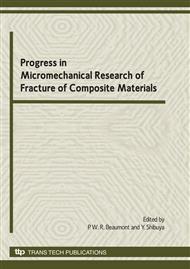p.1
p.19
p.31
p.41
p.47
p.53
p.69
Fracture Energy and Fracture Behavior of Short-Fiber-Reinforced SMC Composites
Abstract:
A probabilistic fracture model is introduced to clarify the influence of the fiber bundle-matrix interfacial condition on the fracture energy and fracture behavior of short-fiber-reinforced SMC composites. In this paper, we focus on the study of the influences of two parameters of the interfacial condition, i.e., the debond stress and the constant which governs the frictional forces acting on the debonding interfaces between fiber bundles and matrix in a debonding process, and then the influences of these parameters on the fracture energy and load-displacement curve are elucidated.
Info:
Periodical:
Pages:
31-40
Citation:
Online since:
March 2010
Authors:
Price:
Сopyright:
© 2010 Trans Tech Publications Ltd. All Rights Reserved
Share:
Citation:


